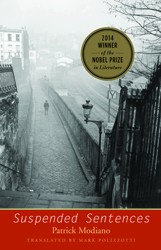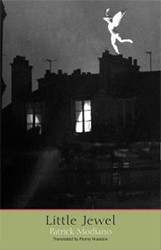PARIS
Missing, a young girl, Dora Bruder, age 15, height, 1 m 55, oval-shaped face, gray-brown eyes, gray sports jacket, maroon pullover, navy blue skirt and hat, brown gym shoes. Address all information to M. and Mme. Bruder, 41 Boulevard, Ornano, Paris.
Nearly fifty years later this small personal ad, dated 31 December 1941, was placed, it caught the attention of Patrick Modiano as he was leafing through an old copy of Paris-Soir. This sparse notice — with an address that drew Modiano back to a neighborhood he once knew well — launched him on a search to find Dora Bruder. Over the course of ten years, Modiano painstakingly and patiently pieced together Dora’s life and death, and in so doing found more places where his life and her family’s intersect.
Modiano traces Bruder through one official paper after another — birth certificate, school records, police reports of her disappearance, the register of her internment before her deportation and final trip — to Auschwitz. He walks the streets she walked. He interviews relatives and the few survivors who were interned with her. He finds photographs of her. He tries to imagine the three months of her disappearance after she ran away from the convent school where her parents had, perhaps, hoped to protect her. He gleans a few facts about her parents. He puts flesh and blood on the starkly efficient records he is able to track down. And in these years of research he finds himself haunted by his own troubling memories of his adolescence, triggered by intersections of his life and Dora’s, and of his conflicted views of his father. In time we learn almost more about Modiano than he learns about Dora Bruder.
Whether it was Modiano’s purpose or not, this is a hard book to classify — biography, memoir, history, to some extent an act of imagination — but ambiguous as it is, it is also hard not to feel the force of the book. The search and desire to know what happened to largely anonymous people command attention as the reader is pulled into the grey heartlessness of the occupation of Paris and the shadows it cast on those who lived through it. Patrick Modiano is the winner of the 2014 Nobel Prize for Literature.
Maron L. Waxman, retired editorial director, special projects, at the American Museum of Natural History, was also an editorial director at HarperCollins and Book-of-the-Month Club.




